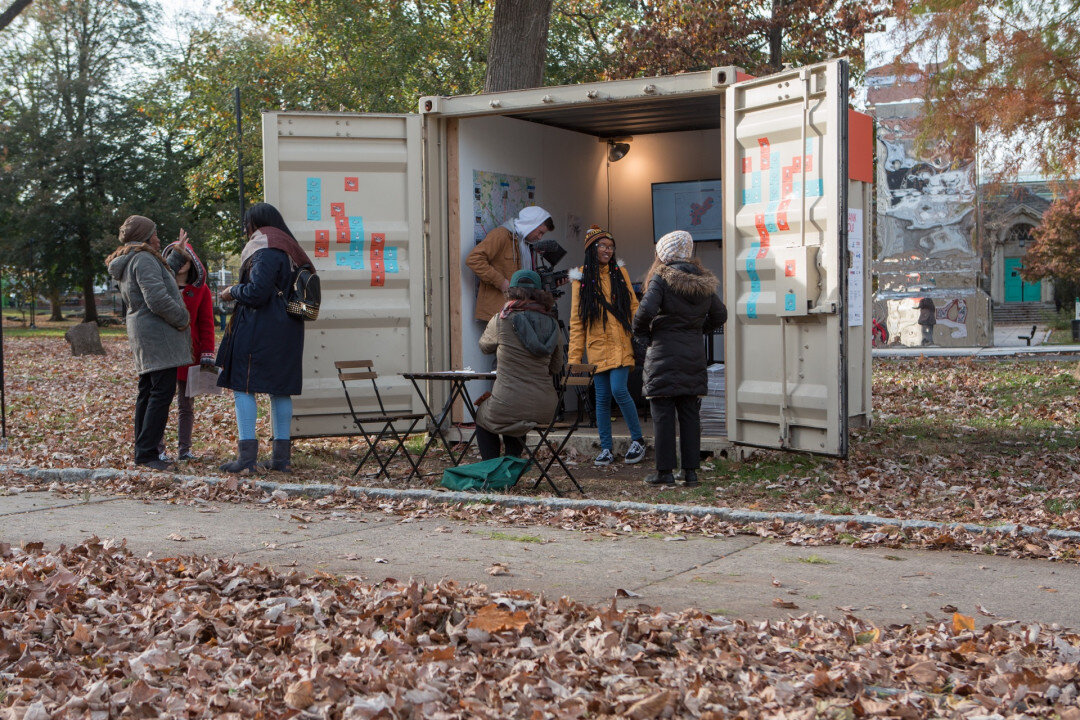Post-Refinery Futures
Memory
Remembering a Slow Disaster
“I’ve lived here all my life, I’ve buried so many people”
-Charles Reeves, Tasker-Morris Neighbors Association
Memory can form a bridge between the refinery site’s future and its complex and harmful history. We have identified four priorities to support the powerful role memory plays in the next chapter of this site:
Support a community-led process
Make space for justice and recognition
Consider the refinery’s physical presence within the city—industrial gateway, legacy, and remediation, and
Acknowledge of adjacent and regional health impacts.
While there are powerful formal and process-based precedents to look to around the world, a challenge to on-site installations is that the refinery is still causing harm, and the impacts of that harm are inequitable. It’s common to find objects and places that effectively engage memory around a tragedy that has passed. It’s less common to find effective precedents in which memory is engaged around a topic or situation that continues to cause harm. As long as the site continues to cause harm, as long as information about its current danger is missing or suppressed, and in the absence of any serious inquiry into the extent of pollution or timeline for remediation, we look to the following models for engaging memory:
Distributed engagement with memory. The Legacy Museum in Montgomery, AL works with racial atrocities in the US, creating space to grieve painful phenomena from lynching to the current crisis of mass incarceration. Its Community Soil Collection Project empowers people throughout the U.S. to collect soil from places where hate crimes occurred, and to memorialize lives lost. Collected soil is then accessioned at The Legacy Museum. This project allows participants to engage with memory around a harmful national phenomenon without leading them into contact with danger, or into an overtly dangerous space.
Paid engagement with memory. Monument Lab is a local organization that has led numerous public projects in Philadelphia that have created short-term jobs to activate spaces or place-based topics. The gravity of the refinery’s harm and its inequitable impacts warrant investing in a well-resourced container for public conversations. Interested/experienced neighbors who can help guide the process should be paid.
Removed engagement with memory. For survivors who lost loved ones to the 2011 Tohoku earthquake and tsunami in Fukushima, a phone booth called the Wind Phone waits for them in a memorial garden at the top of a nearby mountain. While areas around the Daiichi Nuclear Power Plant are closed for decades of decommissioning and containment, many have engaged with memories of loved ones at the safely removed Wind Phone.
Phased engagement with memory. Superfund sites like Palmerton in the Lehigh Gap offer a useful precedent for phased remediation. Currently an ecological research site, the Palmerton Superfund site has undertaken an experimental replanting process in an area where zinc smelting killed all vegetation. Areas have opened to the public as they have become environmentally stable and safe, through remediation. Superfund status also funds ongoing interpretive services for visitors, and helps the public understand the remediation process surrounding them.
Engaging memory at the site doesn’t cue up a procedural formality between institutions and community neighbors. Memory orients attention in two ways—inwards to the site and its history, and also outwards to the systems and structures that exploited the refinery for half a century, despite the harm it caused. For this reason some of the most important precedents for engaging memory include nuclear disaster areas that subsequently committed to clean energy. Where harm has been caused, memory calls in accountability to transition from systems that rely on harming to systems that undo harm. This is the underlying point of engaging memory at the refinery site.
Supported
Monument Lab is a local organization that has activated public space and memory through numerous public programs. The gravity of the refinery’s harm and its inequitable impacts suggest that interested neighbors who can help guide engagement with memory be engaged as paid staff in this effort.
Distributed
The Legacy Museum works with racial atrocities that persist in the US, creating space to grieve the pain they cause. The Soil Collection Project empowers communities to collect soil to memorialize lives lost. This nationwide project allows participants to engage with memory and pain safely.
Removed
A phone booth called the Wind Phone waits for those who lost loved ones in the Fukushima earthquake at the top of a nearby mountain. While areas around the Daiichi Nuclear Power Plant are closed for decades of decommissioning, many have engaged with memories of loved ones at the safely removed Wind Phone.


